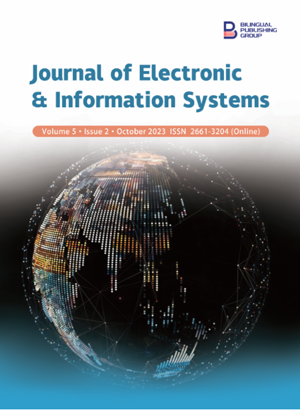Practical Considerations for Implementing Adaptive Acoustic Noise Cancellation in Commercial Earbuds
DOI:
https://doi.org/10.30564/jeis.v5i2.5998Abstract
Active noise cancellation has become a prominent feature in contemporary in-ear personal audio devices. However, due to constraints related to component arrangement, power consumption, and manufacturing costs, most commercial products utilize fixed-type controller systems as the basis for their active noise control algorithms. These systems offer robust performance and a straightforward structure, which is achievable with cost-effective digital signal processors. Nonetheless, a major drawback of fixed-type controllers is their inability to adapt to changes in acoustic transfer paths, such as variations in earpiece fitting conditions. Therefore, adaptive-type active noise control systems that employ adaptive digital filters are considered as the alternative. To address the increasing system complexity, design concepts and implementation strategies are discussed with respect to actual hardware limitations. To illustrate these considerations, a case study showcasing the implementation of a filtered-x least mean square-based active noise control algorithm is presented. A commercial evaluation board accommodating a low-cost, fixed-point digital signal processor is used to simplify operation and provide programming access. The earbuds are obtained from a commercial product designed for noise cancellation. This study underscores the importance of addressing hardware constraints when implementing adaptive active noise cancellation, providing valuable insights for real-world applications.
Keywords:
Active noise cancellation; Adaptive filter; DSP implementationReferences
[1] Liebich, S., Fabry, J., Jax, P., et al. (editors), 2018. Signal processing challenges for active noise cancellation headphones. Speech Communication; 13th ITG-Symposium; 2018 Oct 10-12; Oldenburg. Berlin: VDE. p. 1-5.
[2] Bai, M., Lee, D., 1997. Implementation of an active headset by using the H∞ robust control theory. The Journal of the Acoustical Society of America. 102(4), 2184-2190.
[3] Goldstein, A.L. (inventor), 2016. Adaptive feedback control for earbuds headphones and handset. Patent Application Publication. US patent. 2016/0300562 A1.
[4] Kim, Y., Park, Y., 2019. CPU-GPU architecture for active noise control. Applied Acoustics. 153, 1-13.
[5] Gan, W.S., Kuo, S.M., 2002. An integrated audio and active noise control headset. IEEE Transactions on Consumer Electronics. 48(2), 242-247.
[6] Morgan, D., 1980. An analysis of multiple correlation cancellation loops with a filter in the auxiliary path. IEEE Transactions on Acoustics, Speech, and Signal Processing. 28(4), 454-467.
[7] Kuo, S.M., Morgan, D.R. (editors), 2000. Review of DSP algorithms for active noise control. IEEE International Conference on Control Applications. Conference Proceedings (Cat. No. 00CH37162); 2000 Sep 27; Anchorage. New York: IEEE. p. 243-248.
[8] Zhong, X., Zhang, D., 2021. Latency prediction of earmuff using a lumped parameter model. Applied Acoustics. 176, 107870.
[9] Zhang, L., Qiu, X., 2014. Causality study on a feedforward active noise control headset with different noise coming directions in free field. Applied Acoustics. 80, 36-44.
[10] Rafaely, B., Jones, M., 2002. Combined feedback—feedforward active noise-reducing headset—The effect of the acoustics on broadband performance. The Journal of the Acoustical Society of America. 112(3), 981-989.
[11] Iwai, K., Kinoshita, S., Kajikawa, Y., 2019. Multichannel feedforward active noise control system combined with noise source separation by microphone arrays. Journal of Sound and Vibration. 453, 151-173.
[12] Hansen, C., Snyder, S., Qiu, X., et al., 2012. Active control of noise and vibration. CRC Press: Boca Raton.
[13] Chang, C.Y., 2009. Efficient active noise controller using a fixed-point DSP. Signal Processing. 89(5), 843-850.
[14] Huang, C.H., Pawar, S.J., Hong, Z.J., et al., 2012. Earbud-type earphone modeling and measurement by head and torso simulator. Applied Acoustics. 73(5), 461-469.
[15] Four ADC, Two DAC, Low Power Codec with Audio DSPs ADAU1787 [Internet]. Analog Devices; 2020. Available from: https://www.analog.com/media/en/technical-documentation/data-sheets/adau1787.pdf
[16] Mohammed, J.R., Singh, G. (editors), 2007. An efficient RLS algorithm for output-error adaptive IIR filtering and its application to acoustic echo cancellation. 2007 IEEE Symposium on Computational Intelligence in Image and Signal Processing; 2007 Apr 1-5; Honolulu. New York: IEEE. p. 139-145.
[17] Graf, J., Reithmeier, E., 2009. Computationally efficient active noise reduction in headsets. Journal of Computer and Systems Sciences International. 48, 567-573.
Downloads
How to Cite
Issue
Article Type
License
Copyright © 2023 Agustinus Oey

This is an open access article under the Creative Commons Attribution-NonCommercial 4.0 International (CC BY-NC 4.0) License.




 Agustinus Oey
Agustinus Oey






